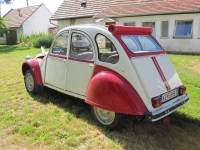Citroen 2CV6

No doubt that this is a very lovely car. Its simplicity and easy-to-get parts made the restoration of this people's car a joyful exercise. The restoration itself included the engine overhauling, fitting new axles and the chassis frame, reconditioning of the seats with new upholstery and a new paint job in two contrasting tones according to the layout provided by the owner.
In 1936, the Citroën engineers led by the ingenious André Lefèbvre, were given the task to build a people's car, a so-called "umbrella on four wheels" - low cost car for farmers and common people, who were not able to afford the ownership of a car until now. The basic premise of this task was to create a car so cheap that it would have no competition in this direction, able to carry four adults together with 50 kilograms of goods, with a suspension soft enough not to break a single egg during a ride on a gravel road through the field. The fuel consumption should not be too much above 3 litres and the top speed not lower than 60 kph.
Even though the development was interrupted by World War II for few years, in 1948 the car was finally unveiled at the Paris Salon.
Nicknames: The whole duckling thing started in Netherlands with de lelijke eend (ugly duckling). In England, the nickname tin snail caught up, or sometimes the more derogatory flying dustbin. In Spain, names such as citrola, citruca or cirila emerged. Swedes called it student Jaguar.
2CV or 3CV? The name 2CV reflects the tax classification in France. The 2CV category was the lowest one, and in case of little new Citroën it was calculated from the engine capacity of 375 ccm. However, our car is fitted new a newer 602 ccm engine, which already falls into the 3CV category - so its name is basically wrong. This fact is not listed in any literature, and we discovered it only after thorough familiarisation with the French tax system.
The ugly duckling remained in production for 42 years.
2CV6 is basically a very simple car. It takes only 4 hours to completely dismantle the car for one mechanic. The world record for disassemble and reassemble is 2 hours and 6 minutes. In our workshop, it took slightly longer.









































